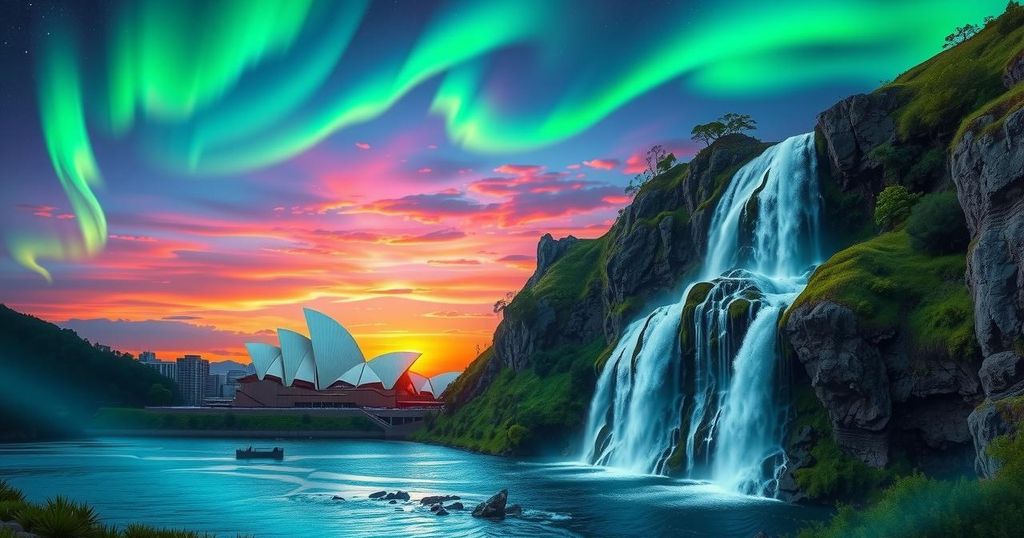Exploring the Sky: Natural Phenomena in Norway, Venezuela, and Australia
This article discusses three remarkable natural phenomena—the Northern Lights in Norway, the lightning storms at Lake Maracaibo in Venezuela, and the Morning Glory Cloud in Queensland, Australia. Each phenomenon attracts significant tourism, positively impacting local economies and enhancing global interest in natural wonders. Destinations are adapting to increasing visitor numbers, promoting sustainable travel and deeper connections with nature.
The sky presents a variety of breathtaking natural phenomena that have fascinated humankind for centuries. Destinations famed for their celestial occurrences not only offer remarkable viewing experiences but also bolster local tourism. Notable phenomena, like the Northern Lights, lightning storms, and the Morning Glory Cloud, draw tourists globally, enhancing the respective countries’ appeal.
The Aurora Borealis, or Northern Lights, ranks among the most iconic celestial displays and continues to attract tourists on a grand scale. This stunning light show results from solar particles interacting with Earth’s atmosphere, generating vibrant colors in high-latitude regions. Countries such as Iceland, Sweden, Finland, and Norway see significant tourism revenues, with estimates exceeding $800 million annually for the Northern Lights alone. Documentaries and the iGaming sector have further heightened interest, promoting these spectacular occurrences.
Tromsø, Norway, is recognized as a prime location for witnessing the Northern Lights. With clear skies from September to April and a more temperate climate, it is widely accessible. For an enhanced experience, visitors often seek out Sommarøy Island, where lower light pollution dramatically improves visibility of the Aurora. Guided tours in these areas increase the chances of experiencing this natural wonder firsthand.
Lake Maracaibo in Venezuela distinguishes itself as the world’s lightning capital, marked by extraordinary lightning storms. With up to 280 storm days each year and as many as 40,000 lightning strikes per event, the phenomenon captivates observers. Evening storms are typically silent, creating an almost surreal atmosphere. Boat tours from Puerto Concha provide the best vantage points for this stunning spectacle, which aids in promoting Venezuela’s tourism.
The Morning Glory Cloud in Queensland, Australia, showcases a unique cloud formation that captivates adventure-seekers. This phenomenon occurs during September and October when warm air interacts with cooler conditions, creating an impressive formation that stretches over 600 miles. It is particularly popular among glider pilots, who ride the updrafts for engine-free flights, enhancing Queensland’s reputation as a destination for extreme sports and natural wonders.
Each of these extraordinary natural phenomena contributes significantly to local travel industries by drawing international visitors. Increased interest in such events spurs on tourism sectors, builds appreciation for natural beauty, and inspires travelers to explore the world’s marvels. As these regions adapt to visitor growth, the bond between nature and tourism continues to strengthen, fostering a deeper connection between people and the environment.
In conclusion, nature astounds with its magnificent occurrences, such as the Northern Lights in Norway, lightning storms in Venezuela, and the Morning Glory Cloud in Australia. These unique experiences create unforgettable memories for travelers while meaningfully impacting local economies. The splendor of these events not only highlights Earth’s beauty but also encourages exploration of its wonders.
Nature offers extraordinary phenomena that captivate individuals and significantly enhance local tourism. Iconic experiences like the Northern Lights, lightning storms in Venezuela, and the Morning Glory Cloud in Australia not only draw numerous visitors but also contribute to the economies of these regions. As travelers seek to explore such marvels, awareness and appreciation for the beauty of our planet continue to grow, fostering a deeper connection with the natural world.
Original Source: www.travelandtourworld.com




Post Comment